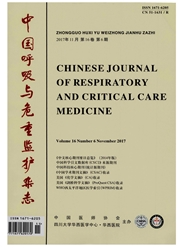

 中文摘要:
中文摘要:
目的探讨大鼠低氧性肺动脉高压(HPH)形成过程中小泛素蛋白样修饰蛋白1(SUMO-1)在肺内表达的动态变化规律及在HPH发病机制中的作用。方法40只Wistar大鼠随机分为常氧对照组、低氧3d组、低氧7d组、低氧14d组及低氧21d组,每组8只。常压间断低氧暴露复制HPH大鼠模型。检测各组大鼠的平均肺动脉压(mPAP)、右心室肥大指数(RVHI)、血管形态学指标[管壁面秽管总面积(WA%)];原位杂交、RT+PCR检测肺内SUMO-1mRNA表达,免疫组化、Western blot检测其蛋白表达水平。结果低氧7d至21d,大鼠肺小动脉开始出现明显血管重塑并逐渐加重,低氧7d时WA%和mPAP显著高于对照组;低氧14d时WA%、mPAP较7d时进一步增加,RVHI显著高于对照组;低氧21d时WA%、RVHI较14d时进一步增加。SUMO-1mRNA和蛋白在对照组肺小动脉壁呈弱阳性表达;低氧3d后显著增高;低氧14d达高峰;低氧21d后mRNA表达减弱但仍然高于对照组,蛋白表达继续保持高水平。SUMO-1mRNA和蛋白表达与mPAP、WA%、RVHI均呈正相关(P均〈0.01)。结论慢性低氧诱导肺内SUMO-1表达增加在HPH的发病过程中发挥一定的作用。
 英文摘要:
英文摘要:
Objective To investigate the dynamic expression of small ubiquitin-related modifiers-1 (SUMO-1) in lung tissue in different phases of rat model of hypoxic pulmonary hypertension (HPH). Methods Forty Wistar rats were randomly divided into 5 groups, and exposed to normoxia or to normobaric intermittent hypoxia for 3,7,14 or 21 days, respectively. Mean pulmonary arterial pressure ( mPAP), right ventricle hypertrophy index ( RVHI), and the ratio of the vessel wall area to the total area ( WA% ) were measured. RT-PCR and in situ hybridization were used to determine the mRNA expression of SUMO-1. Immunohistochemistry and Western blot were used to determine the protein expression of SUMO-1. Results The hypoxic rats developed pulmonary vascular remodeling in pulmonary arterioles after 7 days of hypoxia, with WA% and mPAP significantly higher than those in the normal control. Pulmonary vascular remodeling aggravated with much higher WA% and mPAP afer 14 days of hypoxia, and reached the peak afer 21 days of hypoxia. SUMO-1 mRNA and protein expression markedly increased after 3 days of hypoxia, and reached peak after 14 days. After 21 days of hypoxia, SUMO-1 mRNA expression weakened but still higher than that in the normal control ( P 〈 0. 05 ), and SUMO-1 protein expression remained stable. SUMO-1 mRNA and protein expression were positively correlated with mPAP, WA% and RVHI ( all P 〈 0. 01 ). Conclusion SUMO-1 is transcriptionally induced in lung tissue under chronic hypoxia, and thus involves in the pathogenesis of HPH.
 同期刊论文项目
同期刊论文项目
 同项目期刊论文
同项目期刊论文
 期刊信息
期刊信息
